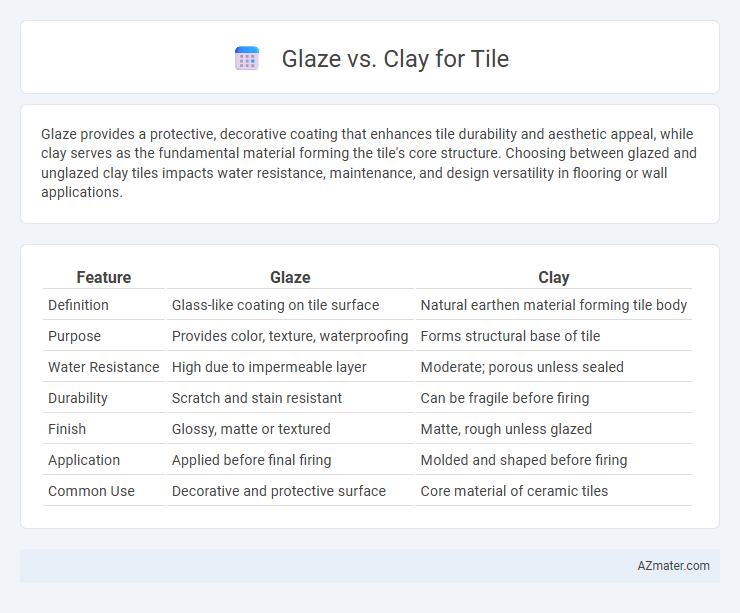Glaze provides a protective, decorative coating that enhances tile durability and aesthetic appeal, while clay serves as the fundamental material forming the tile's core structure. Choosing between glazed and unglazed clay tiles impacts water resistance, maintenance, and design versatility in flooring or wall applications.
Table of Comparison
| Feature | Glaze | Clay |
|---|---|---|
| Definition | Glass-like coating on tile surface | Natural earthen material forming tile body |
| Purpose | Provides color, texture, waterproofing | Forms structural base of tile |
| Water Resistance | High due to impermeable layer | Moderate; porous unless sealed |
| Durability | Scratch and stain resistant | Can be fragile before firing |
| Finish | Glossy, matte or textured | Matte, rough unless glazed |
| Application | Applied before final firing | Molded and shaped before firing |
| Common Use | Decorative and protective surface | Core material of ceramic tiles |
Introduction to Glaze and Clay in Tile Making
Glaze and clay are fundamental materials in tile making, each defining the tile's texture, durability, and appearance. Clay serves as the base material composed of natural minerals, shaping the tile's structure and strength through firing at high temperatures. Glaze is a vitreous coating applied on top, providing color, shine, and added protection against moisture and wear.
What is Clay? – Core Material of Tiles
Clay is the fundamental natural material used in tile manufacturing, composed primarily of fine-grained minerals such as kaolinite and illite. It provides structural integrity and durability to tiles through a process of molding, drying, and firing at high temperatures. The mineral composition and firing temperature influence the tile's strength, porosity, and color before any glaze is applied for surface finish.
What is Glaze? – The Protective Tile Coating
Glaze is a glass-like coating fused onto the surface of ceramic or porcelain tiles through high-temperature firing, providing a durable, water-resistant barrier that protects the tile from stains, scratches, and moisture. This protective tile coating enhances the tile's aesthetic appeal by offering a glossy or matte finish while maintaining ease of cleaning and maintenance. Glazed tiles are ideal for high-traffic areas and wet environments due to their enhanced durability and resistance to wear and tear compared to unglazed clay tiles.
Key Differences Between Glaze and Clay
Glaze on tile creates a smooth, glass-like surface that enhances durability, water resistance, and color vibrancy, while clay tile remains porous, offering natural texture and breathability but lower moisture protection. Glazed tiles suit indoor areas requiring easy cleaning and stain resistance, whereas clay tiles excel in outdoor or rustic settings due to their natural, earthy appearance and better traction. The firing process differs as glazed tiles undergo a second firing to seal the surface, whereas clay tiles are fired once, preserving their raw, tactile quality.
The Role of Clay in Tile Durability
Clay plays a crucial role in tile durability by providing a strong, natural foundation that withstands wear and pressure over time. The mineral composition of clay impacts the tile's density and porosity, directly influencing its resistance to cracking and water absorption. High-quality clay enhances the structural integrity of tiles, making them more durable even before glaze is applied.
The Role of Glaze in Tile Appearance
Glaze significantly enhances tile appearance by adding a glossy or matte finish, which improves color vibrancy and surface texture, making tiles more visually appealing. It acts as a protective layer that resists stains, scratches, and moisture, preserving the tile's aesthetic qualities over time. Unlike clay tiles, which have a natural, earthy look, glazed tiles offer a wider range of design options and customizable patterns due to their surface treatment.
Performance: Glazed vs. Unglazed Tiles
Glazed tiles offer a durable, water-resistant surface that resists stains and scratches, making them ideal for high-traffic areas and wet environments like kitchens and bathrooms. Unglazed clay tiles, while more porous and prone to staining, provide superior slip resistance and a natural, earthy aesthetic favored in outdoor and rustic settings. Performance differences arise from glazed tiles' protective coating, enhancing longevity and ease of maintenance compared to the porous, more absorbent nature of unglazed clay tiles.
Aesthetic Options: Color and Texture Variations
Glaze offers an extensive range of vibrant colors and intricate patterns, providing rich aesthetic options with glossy, matte, or satin finishes that enhance tile surfaces. Clay tiles present natural earth tones with unique textural variations, offering a rustic and organic appearance that evolves with age. Combining glazed and clay elements allows for versatile design choices suitable for both contemporary and traditional settings.
Maintenance and Cleaning Differences
Glazed tile features a smooth, sealed surface that repels stains and moisture, making maintenance easier with simple wiping or mopping to remove dirt and spills. Unglazed clay tiles are porous, requiring regular sealing and more intensive cleaning to prevent staining and water absorption. Over time, clay tiles demand more effort to maintain their appearance, while glazed tiles offer low-maintenance durability ideal for high-traffic areas.
Choosing the Right Tile: Glaze and Clay Considerations
Selecting the right tile involves understanding the differences between glaze and clay options, where glazed tiles feature a durable, glass-like surface that resists stains and moisture, making them ideal for bathrooms and kitchens. Clay tiles, such as terracotta, offer natural porosity and a rustic appearance but require sealing to prevent water absorption and damage. Consider the environment and maintenance needs, as glazed tiles provide easy cleaning and greater durability, while clay tiles deliver unique aesthetics and breathability for less humid spaces.

Infographic: Glaze vs Clay for Tile
 azmater.com
azmater.com